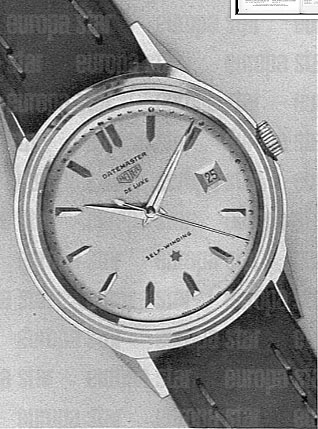By Bruce Shawkey
Most collectors are familiar with Certina watches, but have you ever heard of Kurth Freres? Freres is Swiss for "brothers" of course, with the two brothers being Adolf and Alfred who opened a movement and supplies factory in Grenchen, Switzerland, in 1906. They came out with the brand name, Certina, in the 1940s. Certina is from the Latin certus, meaning assured, or certain. Kurth Freres were quite innovative and produced many inhouse Calibers over the decades. As a budding watch collector, I myself thought Certina was the company name until I called a supply house one time and requested a part for a Certina watch. "You mean a Kurth Freres part," replied the materials man.
Anyway, here are some advertisemenrs and images culled from issues of Europa Star from the '50s;
 ean
ean




In 1954, Cortebert introduced what was probably their craziest ever name for a watch, the "Spirofix." It was advertised as the watch that had everything one would want in watch ... waterproof, dustproof, shockproof, luminous raised figures, waterproof crown, and so forth. They forgot to mention that the watch didn't have a date calendar. They also didn't mention that the watch was not automatic, nor did the dial have the word "automatic" printed or applied onto the dial. Pretty major oversight if you ask me. And what about that name ... the "Spirofix." Watch companies were simply running out of names to call their watches. Nevertheless, the watch was heralded as a breakthrough at a time when it was difficult to stick out in the crowded field of watches. This was a time when watch companies were coming out of the woodwork to satisfy pent-up demand caused by war-time shortages.
Cortebert, as most know, was one of the oldest watch firms in the world, having been founded in 1790 by Abraham-Louis Juillard in the village of Cortebert. The brand is virtually unknown today, save for a few enthusiast collectors who are familiar with the brand. At one time, Cortebert was very popular in Europe and was highly regarded as a premium brand. They manufactured their own movements which they supplied to other highly regarded brands. They even produced a jump-hour movement later adopted by IWC. They were one of many companies that fell victim to the the quartz crisis in the '70s, and are all but forgotten today.
here are some additional Cortebert watches and advertisements through the decades:

Cortebert was found in the village of La Chaux de Fonds, Switzerland, in 1790 by Abraham-Louis Juillard in the village of Cortebert. The brand name was apparently not registered until 1855, according to “Swiss Timepiece Makers, 1775-1975” two-volume encyclopedia by Kathleen H. Prtichard, Phoenix Publishing, 1997. It became a well known and respected brand because they made many, if not most, of their own movement calibers, including railroad watches used in Switzerland and Europe, especially Italy. They were a regular exhibitor at annual watch exhibition in Basel, Switzerland, in the 1940s and ‘50s. The brand continued into the 1970s, but fell victim to the quartz revolution and as far as I am aware, the brand is not currently marketed. There is not a lot of information about the company or its watches because a 1959 fire consumed the entire town archives. Vintage Cortebert watches draw a small by loyal following. For more information on Cortebert, see https://www.justcollecting.com/miscellania/cortebert-watches.
 |
Ref. 1659148. 18kt gold case and bracelet, circa 1950s
 |
| Swiss Watch & Jewelry Journal March/April 1953 |
 |
Jan/Feb 1954 Swiss Watch & Jewelry Journal

Jan/Feb 1954 Swiss Watch & Jewelry Journal
Here's an article from a 1960s issue of Europa Star magazine announcing the 170th anniversary of Cortebert:
|










 ean
ean 

















